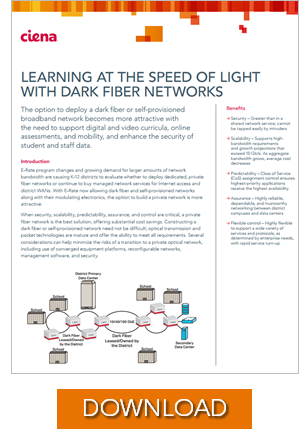3 Classroom Tech Trends Impacting Your Education Broadband Network
Education has come a long way from my day when it was one-size-fits-all and classroom “technology” was a textbook, overhead projector, and (in some cases) a calculator. Fast forward to today, when new technologies are enabling an evolution in digital curriculum, learning analytics, and individualization of education. Mobile devices are transforming the delivery and consumption of education from exclusively in the classroom to anywhere at anytime. Students today expect a digital, mobile learning experience.
Today, education technology leaders are faced with providing a technology infrastructure that can support a rapidly changing learning paradigm; the successful implementation of many educational technology advancements relies heavily on the underlying broadband infrastructure. According to the 2016 COSN IT Leadership survey, broadband and network capacity is a top priority for IT Leaders. However, too often these broadband networks are still leveraging legacy network technologies and architecture that were developed decades ago in a time before the explosion of classroom and educational technology.
With all this in mind, consider the following three trends that will significantly impact your broadband network.
While personalized learning is still in its early stages, the premise includes the ability to allow for 24/7 learning and requires the implementation of learning management systems, student information systems, and other software to distribute assignments, manage schedules, and communications and to dynamically adjust to student progress. Connectivity that enables access from the classrooms and campuses to these cloud-based software applications—and between campuses and district data centers—will have to be secure, highly available, and resilient.
2. Digital Curriculum & Streaming Video
The growing popularity and migration to online learning tools, web-based rich content (such as video), interactive digital textbooks, e-books, online assessments, and the increasing dependence on the Internet for student and teacher learning will continue to contribute to rapidly increasing and fluctuating flows of digital traffic, demanding more and more bandwidth—especially when combined with online assessments.
3. BYOD Mobile Devices in the Classroom
Educators at all levels are finding new ways to integrate mobile devices into the educational experience. In both higher education and K-12, the ability to put information technology in the students’ hands is revolutionizing the way they learn and enabling innovative use of technology in the classroom—displacing traditional lectures and textbooks with new, interactive models. However, the increasing utilization of mobile devices in the classroom and across the school campus has a significant impact on the campus broadband network capacity and introduces new vulnerabilities to cyber attack.
Bandwidth availability and capacity have an increasing impact on student performance. Scalable, reliable broadband is essential to educators who want to be able to make the most of new educational technologies, the digitization of education, and the available online resources and opportunities for teacher and student development. This is putting an increasing strain on education networks that could undermine decades of investment and efforts in using technology to make schools more efficient in terms of operations and to allow students and teachers access to quality learning resources and experiences.
Is your education broadband network ready? If not, then it might be time to rethink your broadband strategy.
Additional Resources:









